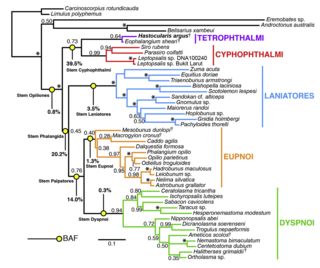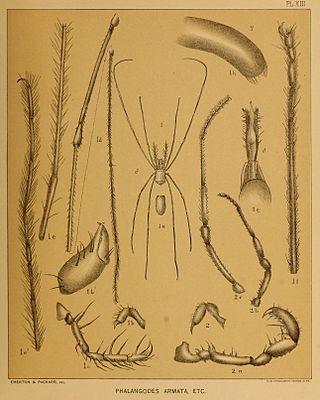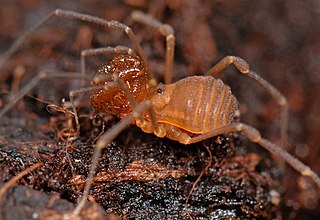
The Opiliones are an order of arachnids colloquially known as harvestmen, harvesters, harvest spiders, or daddy longlegs. As of April 2017, over 6,650 species of harvestmen have been discovered worldwide, although the total number of extant species may exceed 10,000. The order Opiliones includes five suborders: Cyphophthalmi, Eupnoi, Dyspnoi, Laniatores, and Tetrophthalmi, which were named in 2014.

Laniatores is the largest suborder of the arachnid order Opiliones with over 4,000 described species worldwide. The majority of the species are highly dependent on humid environments and usually correlated with tropical and temperate forest habitats.

Lacronia is a genus of South American harvestmen, which includes four Brazilian species. A striking diagnostic character is the trochanter IV of male with strong medial prolateral apophysis forming a pincer with the dorso-apical apophysis of coxa IV.

Pachylinae is the most diverse subfamily of the harvestman family Gonyleptidae, including around 400 valid species. Major groups of species occur in the Brazilian Atlantic forest, Bolivian/Peruvian highlands, Argentina and Chilean temperate forest.

Cosmetidae is a family of harvestmen in the suborder Laniatores. With over 700 species, it is one of the largest families in Opiliones. They are endemic of the New World with a Nearctic-Neotropical distribution where a large fraction of the diversity of Opiliones are represented by this single family. Cosmetidae have the northern extent of their range into the USA, where a small number species occur in the southern states. However, the family is especially diverse in Mexico, Central America and northern South America; especially the Andean realms. Their range also extends further south into Argentina and southern Brazil, but they are absent in Chile. Cosmetidae are prevalent in Amazonian region, but only relatively few also occur in Brazilian Atlantic Forest. Several species are also found in the Caribbean.

The Cranaidae are a family of neotropical harvestmen within the suborder Laniatores.
The Icaleptidae are a small family of neotropical harvestmen within the suborder Laniatores. Although only two species have been described, many more are probably to be discovered.

Harvestmen (Opiliones) are an order of arachnids often confused with spiders, though the two orders are not closely related. Research on harvestman phylogeny is in a state of flux. While some families are clearly monophyletic, that is share a common ancestor, others are not, and the relationships between families are often not well understood.
Caelopyginae is a neotropical sub-family of harvestmen in the family Gonyleptidae.

Theromaster is a genus of armoured harvestmen in the family Cladonychiidae. There are at least two described species in Theromaster, found in the eastern United States.

Travunioidea is a superfamily of armoured harvestmen in the order Opiliones. There are 4 families and more than 70 described species in Travunioidea.
Wespus is a genus of armoured harvestmen in the family Phalangodidae. There is at least one described species in Wespus, W. arkansasensis.

Vonones is a genus of armoured harvestmen in the family Cosmetidae. There are at least two described species in Vonones.
Enigmina is a genus of armoured harvestmen in the family Phalangodidae. There are at least two described species in Enigmina.

Crosbyella is a genus of armoured harvestmen in the family Phalangodidae. There are about five described species in Crosbyella.

Megacina is a genus of armoured harvestmen in the family Phalangodidae. There are at least four described species in Megacina.

Phalangodes is a genus of armoured harvestmen in the family Phalangodidae. There is at least one described species in Phalangodes, P. armata.

Cryptomastridae is a family of armoured harvestmen in the order Opiliones. There are two genera and four described species in Cryptomastridae, found in Oregon and Idaho.
Buemarinoa is a genus of armoured harvestmen in the family Cladonychiidae. There is one described species in Buemarinoa, B. patrizii, found in Sardinia, Italy.
Metasarcidae is a family of harvestmen, first described by Adriano B. Kury in 1994.













